
Royal Botanic Gardens, Kew is a non-departmental public body in the United Kingdom sponsored by the Department for Environment, Food and Rural Affairs. An internationally important botanical research and education institution, it employs 1,100 staff. Its board of trustees is chaired by Dame Amelia Fawcett.

In the botanical classification of plants, Aeridinae Pfitzer is a subtribe of the tribe Vandeae whose representatives all have a monopodial growth habit and do not possess pseudobulbs.

Aerides, known commonly as cat's-tail orchids and fox brush orchids, is a genus belonging to the orchid family. It is a group of tropical epiphyte orchids that grow mainly in the warm lowlands of tropical Asia from India to southern China to New Guinea. They are valued in horticulture for their racemes of showy, fragrant, colorful flowers.

Frederick William Thomas Burbidge (1847–1905) was a British explorer who collected many rare tropical plants for the famous Veitch Nurseries.

The hybrid elm cultivar Ulmus × hollandica 'Dampieri', one of a number of cultivars arising from the crossing of the Wych Elm U. glabra with a variety of Field Elm U. minor, is believed to have originated in continental Europe. It was marketed in Wetteren, Belgium, in 1851 as 'Orme de Dampier', then in the Low Countries in 1853, and later identified as Ulmus campestris var. nuda subvar. fastigiata DampieriHort., Vilv. by Wesmael (1862).
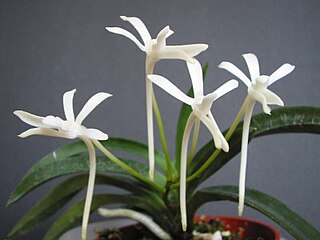
Neofinetia was a genus of flowering plants from the orchid family, Orchidaceae, that is now regarded as a synonym of Vanda. It contained three species and was distributed in China, Korea, and Japan.

× Aeridovanda, abbreviated in trade journals Aerdv, is an intergeneric hybrid between the orchid genera Aerides and Vanda. It is now the accepted name for several former hybrid genera, since Ascocentrum and Neofinetia are now both synonymous with Vanda.

Geissorhiza is a genus with 103 species described to date of deciduous perennial flowering plants in the family Iridaceae first described as a genus in 1803. The entire genus is endemic to Cape Province of western South Africa. The genus name is derived from the Greek words geisson, meaning "tile", and rhizon, meaning "root".

Aerides crispa is a species of epiphytic orchid native to western India and grows at an elevations of 800-1200.Inflorescens is a 40-50 cm long, erect to arching, branched, 20 to 25 flowered cluster, carrying fragrant flowers.
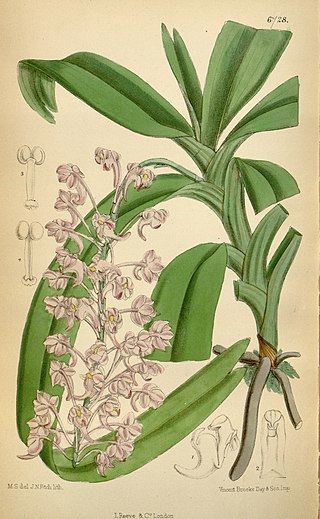
Aerides emericii is a species of epiphytic orchid. It is endemic to the Andaman and Nicobar Islands in the Bay of Bengal.

Aerides falcata is a species of epiphytic orchid native to Yunnan, Vietnam, Thailand, Laos, Cambodia, Myanmar.
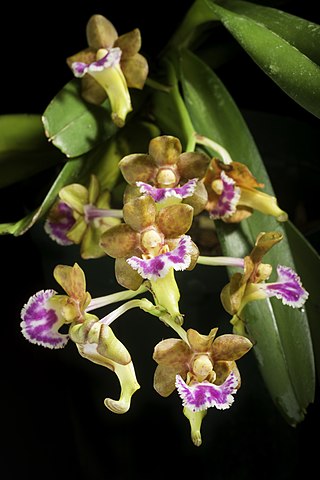
Vanda flabellata is a species of epiphytic orchid native to the Chinese province Yunnan, Laos, Vietnam and Thailand. It was erroneously reported to occur in Myanmar.

Aerides maculosa is a species of orchid endemic to India. The epithet "maculosa" means "spotted", in reference to the colored spots on the tepals.

Aerides multiflora, the multi-flowered aerides, is a species of orchid, native to Southeast Asia, the Coromandel Coast, and Bangladesh.
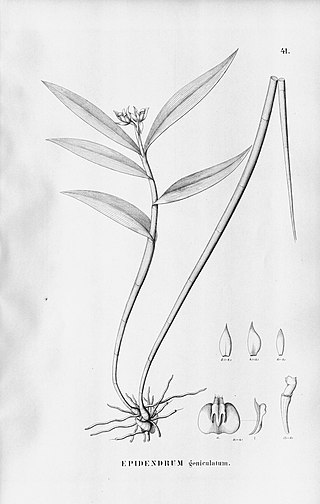
Epidendrum geniculatum is a deciduous, sympodial, caespitose orchid native to the Brazilian states of Espírito Santo and Rio de Janeiro, at elevations from 300 – 800 m.

Kew Gardens is a botanic garden in southwest London that houses the "largest and most diverse botanical and mycological collections in the world". Founded in 1840, from the exotic garden at Kew Park, its living collections include some of the 27,000 taxa curated by Royal Botanic Gardens, Kew, while the herbarium, one of the largest in the world, has over 8.5 million preserved plant and fungal specimens. The library contains more than 750,000 volumes, and the illustrations collection contains more than 175,000 prints and drawings of plants. It is one of London's top tourist attractions and is a World Heritage Site.
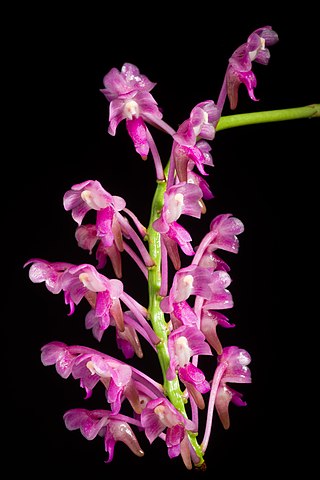
Aerides leeana is a species of plant in the family Orchidaceae. It is endemic to the Philippines. Its natural habitat is subtropical or tropical moist lowland forests. It is threatened by habitat loss.
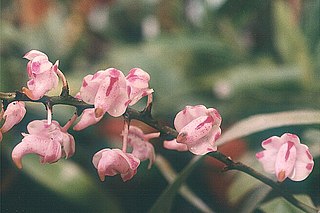
Aerides odorata is a species of plant in the Orchidaceae. It is widespread across much of Southeast Asia, found in the lowland forests of China, Himalayas, Bhutan, Assam, Bangladesh, India, Nepal, Andaman and Nicobar Islands, Myanmar, Thailand, Laos, Cambodia, Vietnam, Peninsular Malaysia, Borneo, Sumatra, Java, Sulawesi, the Lesser Sunda Islands, and the Philippines. Its natural habitat is subtropical or tropical moist lowland forest. It is threatened by habitat loss.

The World Checklist of Selected Plant Families was an "international collaborative programme that provides the latest peer reviewed and published opinions on the accepted scientific names and synonyms of selected plant families." Maintained by the Royal Botanic Gardens, Kew, it was available online, allowing searches for the names of families, genera and species, as well as the ability to create checklists.

Vanda ampullacea is a perennial epiphytic orchid found in southeast Asia from Nepal to China and India, including the eastern Himalayas. It has had various classifications, initially called Aerides ampullacea by William Roxburgh when it was first described in 1814. It was most recently reclassified in 2012 during a taxonomic revision of Vanda. In 1868, one if its cultivars received a First Class Certificate from the Royal Horticultural Society.


















